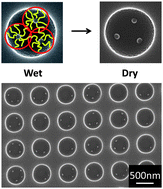Template directed assembly of dynamic micellar nanoparticles
Abstract
The ability to pattern functional

* Corresponding authors
a
Department of Materials Science and Engineering, Frederick Seitz Materials Research Laboratory and Beckman Institute, University of Illinois at Urbana Champaign, 1304 West Green Street, Urbana, IL, USA
E-mail:
pbraun@illinois.edu
b Department of Mechanical Science and Engineering, Frederick Seitz Materials Research Laboratory, University of Illinois at Urbana Champaign, Urbana, IL, USA
c NSF Center for Micro-Engineered Materials, Chemical and Nuclear Engineering Department, University of New Mexico, Advanced Materials Laboratory, Sandia National Laboratories, Albuquerque, New Mexico, USA
The ability to pattern functional

 Please wait while we load your content...
Something went wrong. Try again?
Please wait while we load your content...
Something went wrong. Try again?
K. A. Arpin, J. H. Pikul, W. P. King, H. Fan and P. V. Braun, Soft Matter, 2011, 7, 10252 DOI: 10.1039/C1SM06078C
To request permission to reproduce material from this article, please go to the Copyright Clearance Center request page.
If you are an author contributing to an RSC publication, you do not need to request permission provided correct acknowledgement is given.
If you are the author of this article, you do not need to request permission to reproduce figures and diagrams provided correct acknowledgement is given. If you want to reproduce the whole article in a third-party publication (excluding your thesis/dissertation for which permission is not required) please go to the Copyright Clearance Center request page.
Read more about how to correctly acknowledge RSC content.
 Fetching data from CrossRef.
Fetching data from CrossRef.
This may take some time to load.
Loading related content
